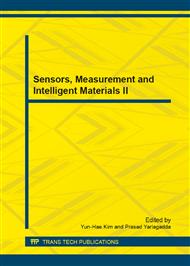[1]
M. Ito, Robot vision modelling—camera modelling and camera calibration, Adv. Robotics 5 (1991), p.321.
DOI: 10.1163/156855391x00232
Google Scholar
[2]
E.L. Hall, J.B.K. Tio, C.A. McPherson, F.A. Sadjadi, Measuring curved surfaces for robot vision, Comput. J. 15 (1982), p.42.
DOI: 10.1109/mc.1982.1653915
Google Scholar
[3]
R.K. Lenz, R.Y. Tsai, Techniques for calibration of the scale factor and image center for high accuracy 3D machine vision metrology, IEEE Trans. Pattern Anal. Mach. Intell. 10 (1988), p.713.
DOI: 10.1109/34.6781
Google Scholar
[4]
M. Penna, Camera calibration: a quick and easy way to detection the scale factor, IEEE Trans. Pattern Anal. Mach. Intell. 13 (1991), p.1240.
DOI: 10.1109/34.107007
Google Scholar
[5]
Y. Liu, T.S. Huang, O.D. Faugeras, Determination of camera location from 2-D to 3-D line and point correspondences, IEEE Trans. Pattern Anal. Mach. Intell. 12 (1990), p.28.
DOI: 10.1109/34.41381
Google Scholar
[6]
J. Batista, H. Araujo, A.T. de Almeida, Iterative multistep explicit camera calibration, IEEE Int. J. Robotics Automat. 15 (1999), p.897.
DOI: 10.1109/70.795794
Google Scholar
[7]
G. -Q. Wei, S. De Ma, Implicit and explicit camera calibration: Theory and experiments, IEEE Trans. Pattern Anal. Mach. Intell. 16 (1994), p.469.
DOI: 10.1109/34.291450
Google Scholar
[8]
O.D. Faugeras, G. Toscani, The calibration problem for stereo, Proceedings of the IEEE Computer Vision and Pattern Recognition, 1986, p.15.
Google Scholar
[9]
Z. Hong, J. Yang, An algorithm for camera calibration using a three-dimensional reference point, Pattern Recognition 26 (1993), p.1655.
DOI: 10.1016/0031-3203(93)90020-w
Google Scholar
[10]
Z. Zhang. A flexible new technique for camera calibration. IEEE Trans. Pattern Anal. Mach. Intell. 22(11) (2000), p.1330.
DOI: 10.1109/34.888718
Google Scholar


